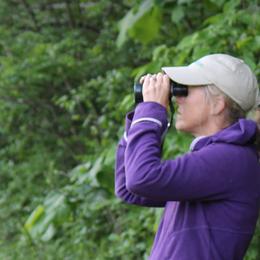The Vermont State Legislature made some important decisions for species that are part of the Vermont landscape.
Today marks a historic milestone for the Bald Eagle in Vermont. After being listed as a state endangered species since 1987, Bald Eagles are now considered a recovered species and are no longer listed in Vermont. Bald Eagles remain protected by federal laws such as the Migratory Bird Treaty Act and the Bald and Golden Eagle Protection Act. Their recovery has been a huge success, thanks to the efforts of a variety of partner organizations and community scientists who monitor and track breeding eagles in the state. Audubon Vermont will continue to play a key role in post-delisting monitoring and management for this species.
Other designations that relate to Audubon Vermont's bird conservation work include the critical habitat designation of the Common Tern and the new threatened listing of the Eastern Meadowlark. Audubon Vermont has been involved in Common Tern recovery for decades; listing the islands where they nest as critical habitat is a signal of the importance of these locations to the species' long-term survival. The Eastern Meadowlark has seen dramatic declines in recent decades, primarily due to changes in agricultural practices. This grassland nesting bird has recently become a rarity in Vermont. Audubon Vermont will continue its work with landowners and land managers to enhance grassland habitat to benefit this species.
Read about Bald Eagle's delisting in Smithsonian Magazine: click here
PRESS RELEASE FROM VERMONT FISH & WILDLIFE:
BALD EAGLE REMOVED FROM STATE ENDANGERED AND THREATENED SPECIES LIST, FIVE OTHER SPECIES AND THREE CRITICAL HABITATS ADDED
“The bald eagle’s de-listing is a milestone for Vermont,” said Wildlife Division Director Mark Scott. “This reflects more than a decade of dedicated work by Vermont Fish & Wildlife and partners. It shows that Vermonters have the capacity to restore and protect the species and habitats that we cherish.”
That conservation capacity will be essential moving forward.
Along with de-listings for the bald eagle and short-styled snakeroot, a flowering plant of dry woodland habitats, Thursday’s update to the State Endangered and Threatened Species List included a range of new listings.
Two invertebrate species, the American bumblebee and a species of freshwater mussel known as the brook floater, and two plant species, Houghton’s sedge and rue anemone, have been listed as endangered. State endangered species are considered at immediate risk of becoming locally extinct in Vermont.
One bird species, the Eastern meadowlark, received a new designation as threatened. State threatened species are considered at risk of becoming endangered without timely conservation action.
Three important landscapes also received new designations as critical habitats that are essential for the survival of threatened or endangered species in Vermont. The newly listed sites support species including the common tern and Eastern spiny softshell turtle, as well as little brown, Northern long-eared, and tricolored bats.
“These new listings reflect the stressors affecting Vermont’s plant, fish, and wildlife species,” said Wildlife Diversity Program Manager Dr. Rosalind Renfrew. “In the face of climate change and habitat loss, our mission is to conserve these species and others to the very best of our ability on behalf of all Vermonters, who demonstrate time and again that they care about the survival of wildlife populations.”
The new listings are a vital step towards enabling the department to carry out that mission. They trigger additions to existing species and habitat management plans, development of recovery metrics, initiation of population monitoring, and strengthening or establishing critical partnerships.
“We dedicate incredible resources through population monitoring, habitat conservation and improvement, and education and outreach to preventing species from reaching these thresholds in the first place,” says Scott. “But, when necessary, we also draw on our successful track record leading endangered species recovery efforts including restoring Vermont’s populations of common loon, osprey, peregrine falcon, and now the bald eagle. We will bring that same dedication to each of these new listings.”
For Immediate Release: February 10, 2022
Media Contacts: Rosalind Renfrew 802 461 8387, Mark Scott 802 777 4217







